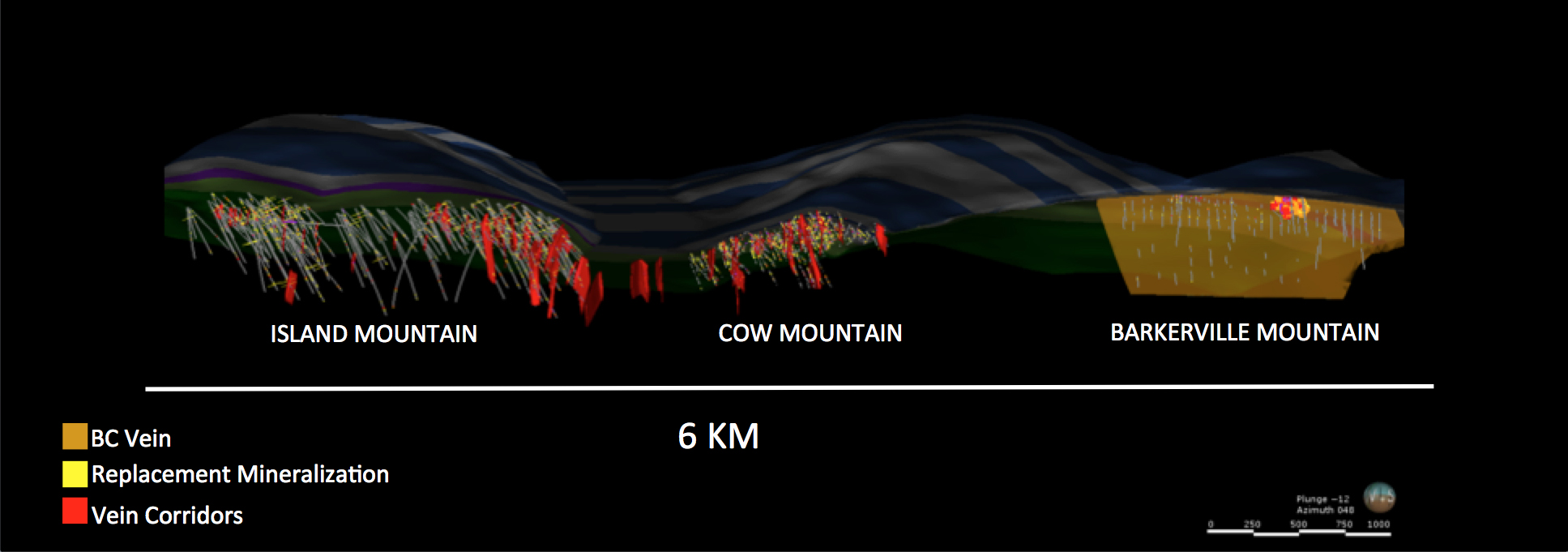NEW BETA CORRIDOR INTERSECTION – 87.66 G/T AU OVER 5.30 METRES
.
TORONTO, ON – October 11th, 2017 – Barkerville Gold Mines Ltd. (TSX.V: BGM) is pleased to announce additional drilling results from the ongoing 130,000 metre Phase II Island Mountain exploration and infill drilling program at the Company’s flagship Cariboo Gold Project.
.
The Company is currently exploring and delineating the Valley and Shaft Zones with nine drill rigs, while a tenth drill is expanding the known mineralization on the BC Vein. Detailed drilling results, a drill hole location plan map and vertical sections are presented at the end of this release. The exact geometry and hence true width of the mineralised zones cannot be assuredly concluded at this time therefore core lengths are reported.
.
Highlights:
- IM-17-145: 20.53 g/t Au over 11.60 metres
- IM-17-145: 87.66 g/t Au over 5.30 metres
- IM-17-145: 17.34 g/t Au over 7.05 metres
- IM-17-162: 13.58 g/t Au over 4.00 metres
- IM-17-163: 11.21 g/t Au over 4.65 metres
- IM-17-163: 13.71 g/t Au over 7.70 metres
.
Veining Corridors Continue to Expand
A newly defined veining corridor, the Beta Corridor, has been extended via the intersection of 20.53 g/t Au over 11.60 metres and 87.66 g/t Au over 5.30 metres at vertical depths of 365 and 415 metres below surface in Phase II drillhole IM-17-145.
.
These new extensions occur 65 metres along vein strike to the northeast of previously reported drillholes IM-17-134 and IM-17-143 which intersected
53.26 g/t Au over 11.55 metres and 7.09 g/t Au over 34.30 metres respectively. The new Beta Corridor pierce points defined by IM-17-145 are untested along vein strike and down dip.
.
Another newly evolving vein network, the Gamma Corridor, was also expanded at a vertical depth of 590 metres below surface by IM-17-145 having intersected 17.34 g/t Au over 7.05 metres. This pierce point is situated 120 metres down plunge of previously reported drillhole IM-17-124 which intersected 12.76 g/t Au over 25.40 metres. Again, this new intersection in the Gamma Corridor is untested at depth and along vein strike.
.
Chris Lodder, President and CEO comments,“As we continue to infill the Shaft Zone we see that there are new parallel corridors starting to be defined in close proximity. Thus, the exploration group has begun identifying these corridors as Alpha, Beta and Gamma and will continue with this nomenclature as new ones develop. The Shaft Zone drilling firmly demonstrates the internal continuity as well as the exploration potential and predictability of the veining networks in undrilled areas”.
.
Shaft Zone – Corridors Discussion
The sandstone hosted veining which constitutes the newly named Alpha, Beta and Gamma Corridors of the Shaft Zone are manifested as an anastomosing network of high vein density with an overall sub-vertical dip and northeast strike. Based upon drilling results to date, estimated horizontal widths of the corridors are variable and range from 5 to 35 metres. These corridors, as well as others that are developing in the Shaft and Valley Zones have been defined from surface to a vertical depth of 600 metres and remain open for expansion to depth and down plunge.
.
Drillhole spacing in the corridors currently averages 25 metres between drilling sections with vertical drilling separations ranging from 20 to 75 metres with hole spacing increasing to depth. Gold grades are intimately associated with vein-hosted pyrite as well as pyritic, intensely silicified wall rock haloes in close proximity to the veins.
.
Qualified Persons
Exploration activities at the Cariboo Gold Project are administered on site by the Company’s Exploration Manager, Maggie Layman, P.Geo. As per National Instrument 43-101 Standards of Disclosure for Mineral Projects, Paul Geddes, P.Geo. Vice President Exploration, is the Qualified Person for the Company and has prepared, validated and approved the technical and scientific content of this news release. The Company strictly adheres to CIM Best Practices Guidelines in conducting, documenting, and reporting its exploration activities on the Cariboo Gold Project.
Quality Assurance – Quality Control
Once received from the drill and processed, all drill core samples are sawn in half, labelled and bagged. The remaining drill core is subsequently stored on site at the Company’s secure facility in Wells, BC. Numbered security tags are applied to lab shipments for chain of custody requirements. The Company inserts quality control (QC) samples at regular intervals in the sample stream, including blanks and reference materials with all sample shipments to monitor laboratory performance. The QAQC program was designed and approved by Lynda Bloom, P.Geo. of Analytical Solutions Ltd., and is overseen by the Company’s Qualified Person, Paul Geddes, P.Geo, Vice President Exploration.
Drill core samples are submitted to ALS Geochemistry’s analytical facility in North Vancouver, British Columbia for preparation and analysis. The ALS facility is accredited to the ISO/IEC 17025 standard for gold assays and all analytical methods include quality control materials at set frequencies with established data acceptance criteria. The entire sample is crushed and 250 grams is pulverized. Analysis for gold is by 50g fire assay fusion with atomic absorption (AAS) finish with a lower limit of 0.01 ppm and upper limit of 100 ppm. Samples with gold assays greater than 100 ppm are re-analysed using a 1,000g screen metallic fire assay. A selected number of samples are also analyzed using a 48 multi-elemental geochemical package by a 4-acid digestion, followed by Inductively Coupled Plasma Atomic Emission Spectroscopy (ICP-AES) and Inductively Coupled Plasma Mass Spectroscopy (ICP-MS).
For further information on Barkerville Gold Mines Ltd. please contact:
Chris Lodder President & Chief Executive Officer
About Barkerville Gold Mines Ltd.The Company is focused on developing its extensive land package located in the historical Cariboo Mining District of central British Columbia. Barkerville’s mineral tenures cover 2,110 square kilometres along a strike length of 67 kilometres which includes several past producing hard rock mines of the historic Barkerville Gold Mining Camp near the town of Wells, British Columbia. The QR Project, located approximately 110 kilometres by highway and all weather road from Wells was acquired by Barkerville in 2010 and boasts a fully permitted 900 tonne/day gold milling and tailings facility. Test mining of the Bonanza Ledge open pit was completed in March of 2015 with 91,489 tonnes of material milled producing 25,464 ounces of gold. The Company has completed several drilling and exploration programs over the past 20 years and has compiled this data with all historical information in order develop geologic models which are assisting management in defining new deposits in the Cariboo Gold Project. An extensive drill program is currently underway with the goal of delineating additional high grade gold mineralization.
Cautionary Statement on Forward -Looking Information
Neither the TSX Venture Exchange (‘TSXV’) nor its Regulation Services Provider (as that term is defined in the policies of the TSXV) accepts responsibility for the adequacy or accuracy of this release. No stock exchange, securities commission or other regulatory authority has approved or disapproved the information contained herein. This news release contains forward-looking information which is not comprised of historical facts. Forward-looking information involves risks, uncertainties and other factors that could cause actual events, results, performance, prospects and opportunities to differ materially from those expressed or implied by such forward-looking information. Forward looking information in this news release includes, but is not limited to, the Company’s objectives, goals or future plans, statements regarding exploration results and exploration plans. Factors that could cause actual results to differ materially from such forward-looking information include, but are not limited to, capital and operating costs varying significantly from estimates, the preliminary nature of metallurgical test results, delays in obtaining or failures to obtain required governmental, environmental or other project approvals, uncertainties relating to the availability and costs of financing needed in the future, changes in equity markets, inflation, fluctuations in commodity prices, delays in the development of projects and the other risks involved in the mineral exploration and development industry, and those risks set out in the Company’s public documents filed on SEDAR. Although the Company believes that the assumptions and factors used in preparing the forward-looking information in this news release are reasonable, undue reliance should not be placed on such information, which only applies as of the date of this news release, and no assurance can be given that such events will occur in the disclosed time frames or at all. The Company disclaims any intention or obligation to update or revise any forward-looking information, whether as a result of new information, future events or otherwise, other than as required by law.












